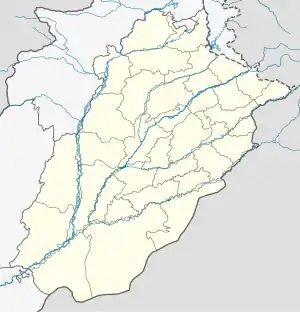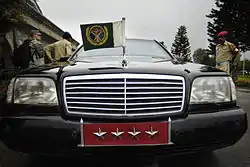General Headquarters | |
|---|---|
| Part of Joint Staff Headquarters | |
| Chaklala, Rawalpindi, Punjab in Pakistan | |
 General Headquarters  General Headquarters | |
| Coordinates | 33°36′N 73°02′E / 33.600°N 73.033°E |
| Type | HQ |
| Site information | |
| Owner | Ministry of Defense (MoD) |
| Operator | Secretariat-I Army |
| Controlled by | Chief of the General Staff |
| Open to the public | No |
| Website | |
| Site history | |
| Built | 1851 (By British Army in India) |
| Built for | National Army HQ of Pakistan Armed Forces |
| Built by | Corps of Engineers (Construction and expansion since 1947) |
| Garrison information | |
| Current commander | Lt-Gen. Avais Dastgir |
| Designations | Army GHQ[1] |
.jpg.webp)
The General Headquarters (Reporting name: Army GHQ: 230 [2][3][4]) is a direct reporting and a general command post of the Pakistan Army, located in the Chaklala at the vicinity of Rawalpindi, adjacent to the Joint Staff Headquarters (JS HQ).[5]
History
In 1851, the British Army in India made an permanent headquarter in Rawalpindi when Marquess of Dalhousie decided to stationed the 53rd Infantry Regiment to protect India from Afghan intervention.[6] In 1854, Robert Milman from the Diocese of Calcutta had built the city's first Garrison Church and a telegraph office.: 189 [7][6] It is also the site where Robert Milman is buried following his death in Rawalpindi in 1876.[6]
On 14 August 1947, General Frank Messervy decided to establish the army headquarters of the Pakistan Army at the Rawalpindi, which was also the headquarter of the Northern Command of the former British Indian Army; Gen. Messervy established it as "Army GHQ", which he derived from GHQ India.[6][8][9] The Army's GHQ was viewed as a temporary post in Rawalpindi since its where Gen. Messervy was based in.: 51 [10] Since its establishment, the Army GHQ in Rawalpindi has faced many problems in civil–military relations context and criticism at broader level since the nation's capital was based in Karachi in past, and now in Islamabad.: 51 [10]: 75 [11] Until 2006, the Army GHQ's command post was based in Rawalpindi but later moved to Chaklala, near the vicinities of the PAF Base Chaklala and the JS HQ military headquarters.[10]
Since 2017, the Pakistan Army has been slowly moving its headquarters to nation's capital, Islamabad to be able to merge with the air force and the navy.[12]
Gates
| Gates | Purpose | Road | |
|---|---|---|---|
| Gate No 1 | General | ||
| Gate No 2 | Exclusively reserved for service/ ex service men | ||
| Gate No 3 | Exclusively reserved for families/ families of martyrs | ||
| Gate No 4 | Exclusively reserved for politicians/ bureaucrats | ||
| Gate No 5 | Exclusively reserved for foreign dignatries | ||
| Gate No 6 | Exclusively reserved for patients visiting CMH/Army Museum | ||
| Gate No 7 | General |
Secretariat
The Pakistan Army's GHQ is a command post of the Pakistan Army where the secretariat of the Chief of the Army Staff functions to ensure the ceremonial and operational command of the army.: 47 [10]
There are ten branches of the Pakistan Army that are headed by the lieutenant-generals and multiple administrative corps that are commanded by the director-generals who are ranked at the major-general.: 47 [10] Each of the army's branches and the director-generals of the administrative corps works under the Chief of the General Staff (CGS).[13] The chief of general staff, who usually heads the Army GHQ Staff, reports directly to chief of army staff on daily routine basis.[13]
Branches of the Pakistan Army
There are ten branches of the Pakistan Army that are headed by the lieutenant-generals and multiple administrative corps that are commanded by the director-generals who are ranked at the major-general.: 47 [10]
The Chief of Army Staff Secretariat is not considered as apart of the army branch but functions separately as an office of the chief of army staff.: 47 [10]
| Branches at the Army GHQ |
| ||||||||||||||||||||||||||||||||||||||||||||||||||||||||||||||||||||||||||||||||||||||||||||||||||||||||||||||||||||||||||||||||||||||||||||||||||||||||||||||||||||||||||||||||||||||||||||||||||||||||||||||||||||||||
(Source: More citations needed) |
Security
Incidents, breaches, and relocation efforts

In 1970s, the Army's GHQ became a focal point of massive arrests and incidents of military police's baton charge on protestors when politicians Sheikh Mujibur Rahman (in 1970) and Zulfikar Ali Bhutto (in 1977) were taken in the custody.: 115 [14]
Due to being a significant command post of the army, the Taliban insurgents have repeatedly carried series of violent terrorist attacks at the premises of the GHQ, with first attack reported in 2007.[1]
To prevent the Taliban's repeated infiltration and to address the issue of increase security, the Army's GHQ (together with JS HQ) has been slowly moving its command infrastructure to Islamabad to integrate with the navy and air force's headquarters that are located in much safer zones of Islamabad, the nation's capital, since 2017.[15]
See also
References
- 1 2 Abbas, Hassan (October 11, 2009). "Deciphering the attack on Pakistan's Army headquarters". Foreign Policy. Foreign Policy. Foreign Policy. Retrieved 2 January 2024.
- ↑ Nawaz, Shuja (2008). Crossed Swords: Pakistan, Its Army, and the Wars Within. Karachi, Sind, Pakistan: Oxford University Press. p. 655. ISBN 978-0-19-547660-6. Retrieved 30 December 2023.
- ↑ Alam, Shah (2012). Pakistan Army: Modernisation, Arms Procurement, and Capacity Building. Vij Books India. ISBN 978-93-81411-20-9. Retrieved 30 December 2023.
- ↑ "General Headquarters (Army)". www.ppra.org.pk. Public Procurement Regulatory Authority. Retrieved 30 December 2023.
- ↑ "What an Indian saw inside the Pakistan Army headquarters". Quartz. December 7, 2018.
- 1 2 3 4 L. P. Sen (1 January 1994). Slender Was the Thread. South Asia Books. p. 26. ISBN 978-0861316922. Retrieved 26 April 2012.
- ↑ Cloughley, Brian (2000). A History of the Pakistan Army: Wars and Insurrections. Oxford University Press: Oxford University Press. p. 435. ISBN 978-0-19-579374-1. Retrieved 2 January 2024.
- ↑ Shreenivas Kumar Sinha (1992). A soldier recalls. Spantech & Lancer. p. 86. ISBN 978-8170621614. Retrieved 26 April 2012.
- ↑ Eqbal Ahmad; Noam Chomsky; Carollee Bengelsdorf; Margaret Cerullo (13 June 2006). The Selected Writings of Eqbal Ahmad (1st ed.). Columbia University Press. p. 592. ISBN 978-0231127110. Retrieved 4 May 2012.
- 1 2 3 4 5 6 7 Cheema, Pervaiz Iqbal (2002). The Armed Forces of Pakistan. NYU Press. ISBN 978-0-8147-1633-5. Retrieved 31 December 2023.
- ↑ Nawaz, Shuja (2008). Crossed Swords: Pakistan, Its Army, and the Wars Within. Oxford University Press. ISBN 978-0-19-547660-6. Retrieved 2 January 2024.
- ↑ Kashif Abbasi (2017-12-27). "Army to be allotted over 1,000 acres for new GHQ, other offices". Dawn Media Group. Retrieved 2019-07-24.
- 1 2 Alam, Dr Shah (1 July 2012). Pakistan Army: Modernisation, Arms Procurement and Capacity Building. Vij Books India Pvt Ltd. ISBN 978-93-81411-79-7. Retrieved 31 December 2023.
- ↑ Khan, Gohar Ayub (2007). Glimpses Into the Corridors of Power. University of Karachi, Sind, Pakistan: Oxford University Press. p. 354. ISBN 978-0-19-547354-4. Retrieved 2 January 2024.
- ↑ "Pakistan Army to get over 1,000 acres for new General Headquarters". The Economic Times. 27 December 2017. Retrieved 2 January 2024.
External links
- Cloughley, Brian (2000). A History of the Pakistan Army: Wars and Insurrections. Oxford University Press: Oxford University Press. p. 435. ISBN 978-0-19-579374-1. Retrieved 2 January 2024.
- Nawaz, Shuja (2008). Crossed Swords: Pakistan, Its Army, and the Wars Within. Karachi, Sind, Pakistan: Oxford University Press. p. 655. ISBN 978-0-19-547660-6. Retrieved 30 December 2023.